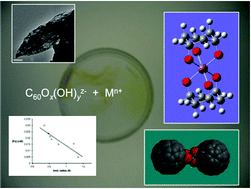Abstract
Metal contamination of water is a serious challenge faced by environmental chemists, but there is also economic value in the removal of metals for recycling or extraction. Our prior observation that hydroxyfullerenes [C60Ox(OH)y]n− act as chelate agents to Fe3+ suggests that these material, or derivatives, may be used for co-precipitation. We report the removal of main group (Al3+, Ag+, Ca2+, and Zn2+) as well transition metal (Fe3+, Co2+, Cu2+, Mn2+, and Ni2+) and lanthanide (La3+ and Nd3+) ions from solution. The resulting complexes have been characterized by XPS, SEM, TEM, and DLS. The competitive binding with Fe3+ shows that the binding affinity with hydroxyfullerenes follows the order: Zn2+ > Co2+ > Mn2+ > Ni2+ > La3+ > Nd3+ > Cd2+ > Cu2+ > Ag+ > Ca2+ > Fe3+ > Al3+. The relative binding ability is dependent on ionic radius; however, divergent trends are observed for M2+ and M3+, i.e., for divalent ions the binding is stronger for smaller ions, while the opposite trend is observed for trivalent ions. Previously the coordination of hydroxyfullerene to metals was assumed to be analogous to a 1,2-diol or catechol. However, while ab initio calculations using [M(catecholate)n]n− (n = 2, 3) provide an explanation of the observed trend for M2+, the use of cis–cis-1,3,5-cyclohexanetriol and cis-1,3-cyclohexanediol as model ligands provides insight into the relative binding efficiency for M3+.

- This article is part of the themed collection: In memory of Professor Kenneth Wade

 Please wait while we load your content...
Please wait while we load your content...